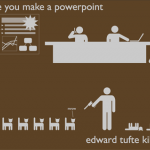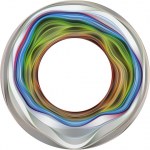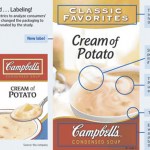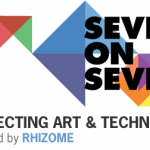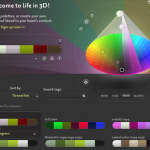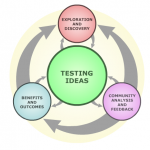Web 2.0, New Media, and Gadgets
This poem by Rosemary Kirstein is truly a worthy successor to the classic by Wallace Stevens. (Thanks to Jen Ouellette for sharing.)
Doesn't that title sound weird - like an experimental film? It may help to know that House of Sweden is Sweden's embassy in Washington, DC - a lovely glass building on the Potomac. If you're in the DC area, you should get on their mailing list, because they host interesting science-related panel discussions and receptions. Yesterday, they opened a new exhibit - the Virtual Autopsy Table. It's a touch-screen tabletop that lets you slice into, rotate, and magnify an MRI-based 3D representation of the human body, all with a brush of a hand:
The Virtual Autopsy Table from Norrkö…
I am glad I waited to buy a new version of Photoshop! This is. . . whoa. The desert and sky are particularly impressive.
Is there an Uncanny Valley for software?
Alan Jacobs finds a quote that beautifully expresses why I don't want a Kindle, and why I wish the iPad were a stylus-friendly Mac tablet:
Of course, you can't take your pen to the screen. When it comes to annotating the written word, nothing yet created for the screen compares to the immediacy and simplicity of a pen on paper. The only effective way to respond to text on screen is to write about it. The keyboard stands in for the pen; but it demands more than a mere underline or asterisk in the margin. It demands that you write.
That, of course, was the reason for the pen all along: it's a…
A little Sunday reading: "Mr. Penumbra's Twenty-Four-Hour Book Store," one of several wonderful short stories by San Francisco writer Robin Sloan. It's sort of like magical realism for techies:
Back at Supply and Demand. The air is crackÂling with wi-ââfi; Kat and I are havÂing the only spoÂken conÂverÂsaÂtion in the entire place.She's wearÂing the same red-ââand-ââyellow "BAM!" t-ââshirt as yesÂterÂday, which means a) she slept in it, b) she owns sevÂeral idenÂtiÂcal t-ââshirts, or c) she's a carÂtoon character--all of which are appealÂing alternatives.
I don't want to come out and conÂfess…
Hi everyone,
I'm officially back from blogcation this week, so thanks for hanging in there while I was (mostly) off the grid! For the next couple of weeks, I'll be slowly wading through the emails and links I got during over the last few weeks.
Plus, I'll not only be posting at BioE, I'll also be contributing over at Collective Imagination, which is focusing this month on technology and personal health, including data visualization and e-health. (These are big interests of mine that I occasionally touch on here at BioE, but are a squarer fit over at CI.) Please pop over and see what you…
When Google started "suggesting" the most popular search phrases below its query box, I was creeped out. Especially when I saw what it suggests for "is Obama". Yes, I was happier when I didn't know what other people were typing into Google.
However, the folks at HINT.fm took the opposite approach: they created an interface that invites you to explore the most popular search phrases for any given starting words. I took it for a spin to see what the American public is asking about you-know-who: scientists. (You totally thought I was going to say Palin, didn't you?)
click image for a larger…
Won't the dismal, subdued palette of winter release its hold on you? Never fear, a stripe of spring magenta is approaching! This infographic by Fernanda Viagas and Martin Wattenberg of HINT.fm depicts the dominant colors in flickr photographs of Boston Common around the year, starting with summer at the top:
It makes me wonder what similar graphics would look like for other geographic regions - or even for flickr photos in general across continents or hemispheres. Would seasonal trends be detectable? Do we compensate for the dismal palette outside by photographing lots of technicolor…
Update: welcome Consumerist readers! While I use my own experience to illustrate concerns about third-party online merchants, this post is mainly about the bigger long-term informational problems I see with reputation, reliability, and online communities. Please feel free to weigh in!
A few weeks ago, I caught a familiar story on the local news. A local citizen had written in to the news team with a request for help after a local furniture company sold them a defective living room set, and wouldn't give them a refund. The news team went to the business, who - wary of the potential public…
Campbell's is redesigning their iconic red-and-white soup packaging. Why? The answer's in your brain - or so they think:
Campbell's said traditional customer feedback wasn't telling the company why soup sales weren't doing so hot. "A 2005 Campbell analysis revealed that, overall, ads deemed more effective in surveys had little relation to changes in sales," the WSJ says.So they turned to "science." Campbell's hired Innerscope Research Inc. to conduct tests on a whopping 40-person sample to see what design elements produced the most "emotional engagement."The team clipped small video cameras…
Google may have done Buzz all wrong, but they do Chrome right in these adorable, Rube Goldberg-style ads.
Jesse ("Jess3") Thomas's brand-new clip, like a slimmed-down, retro-styled, updated cousin of that ubiquitous "Right here, right now" video, is the perfect appetizer to complement the Pew's brand-new report on participatory news. Enjoy.
A provocative post over at the Intersection.
I haven't had time to weigh in on the vitriol-slinging because I'm on blogcation - and honestly, the stuff Sheril describes is one of the very reasons I decided to take a blogcation. But knowing that I'll be attacked for saying it, yes, I agree with her that hateful ad hominem attacks are increasing in the science blogosphere, it's nauseating, and it doesn't reflect well on any of us.
In Cambridge, at a "Wireside chat" on "Fair Use, Politics, and Online Video" by legal scholar, IP expert and corrupt-government critic Lawrence Lessig. He's comparing the addictivity/potential danger of wifi to smoking. Say it ain't so! I need my wifi!
Feb 23rd (tomorrow) is the last day to snag advance tickets to the Seven on Seven conference in NYC:
Seven on Seven will pair seven leading artists with seven game-changing technologists in teams of two, and challenge them to develop something new --be it an application, social media, artwork, product, or whatever they imagine-- over the course of a single day. The seven teams will unveil their ideas at a one-day event at the New Museum on April 17th.
If you go, let me know how it is!
Okay, so most people don't even bother to read EULAs. But I'm glad we glanced at this one, by Ben Long for his Photoshop Action Pack:
You can use these actions for anything you like, and you can give them to your friends and co-workers (or even your enemies, if your experience of the actions leads you to believe that that's where the real worth of this software lies). However, if you give them to someone else, you must give them the whole package including the installer, documentation, sample workï¬ows, and a kiss on the cheek. You must then stand on one foot and cluck like a chicken. (Man, I…
Those of you who like to play with color may be interested in the newColoRotate interface, designed to make editing color palettes more intuitive. This tool was produced by the same team that made the useful educational website Causes of Color, which I've blogged about before. It explains the differences between iridescence, interference, luminescence, etc. in simple language easy for nonscientists to understand.
There's a quick demo video of the ColoRotate Photoshop plugin below the fold.
An interactive flowchart/concept map from Berkeley's Understanding Science project. Click around a while, and tell me what you think of it. Accurate? Too simple? Useful?

